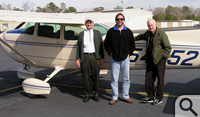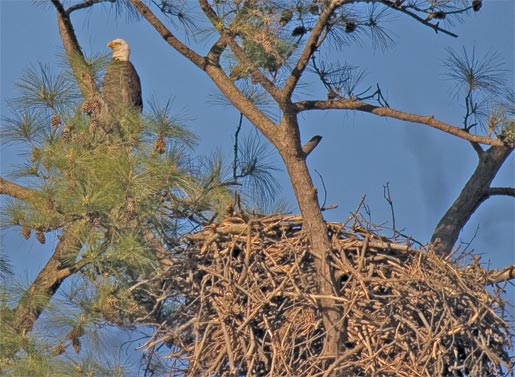Bumper crop of bald eagles
Scientists log a record number of breeding pairs along the James River
The bald eagle breeding population along the James River has set a new record, with 165 breeding pairs of the birds documented in early March.
That number, likely to increase, has surpassed the 154 breeding pairs spotted last year on the James River. The figures were recently announced by Bryan Watts, director of the Center for Conservation Biology. The center conducts an annual series of low-altitude flights in a small plane to spot nests of the birds.
For the past half century, the Center has documented the bald eagle’s return to the James River and Virginia’s portion of the Chesapeake Bay and its tributaries. The James is the only major tributary within the Chesapeake Bay watershed in which the bald eagle population was completely lost, Watts said.
“The historic river supported no breeding pairs in the late 1970s, due to high levels of kepone, DDT and other pollutants,” Watts said. “For the population to recover to this level in just 30 years is a testament to the resiliency of both the eagle population and the great river on which it depends.”
 Watts and his colleague are continuing their census flights, working their way up the Chesapeake. They have several more flying days left in the first round of the 2011 census. Later in the spring, they’ll start the second round—“productivity flights” in which the researchers check known nest sites for chicks. The productivity flights often reveal previously undocumented nesting sites, Watts said, adding that he expects the productivity flights to increase the total of breeding eagle pairs documented along the James River.
Watts and his colleague are continuing their census flights, working their way up the Chesapeake. They have several more flying days left in the first round of the 2011 census. Later in the spring, they’ll start the second round—“productivity flights” in which the researchers check known nest sites for chicks. The productivity flights often reveal previously undocumented nesting sites, Watts said, adding that he expects the productivity flights to increase the total of breeding eagle pairs documented along the James River.
Total may hit 170 pairs
“It wouldn’t surprise me if we top 170 pairs on the James this year,” Watts said, “but that will have to wait until the next round.”
In addition to the record number of breeding pairs, James River survey itself has set a record. The first aerial survey of the James was conducted in 1962 by Richmond native Fred Scott. Watts pointed out that 2011 marks the 50th consecutive breeding season that the population has been surveyed from the air, making the survey the longest-running eagle census in the country.
This year also represents the 35th consecutive year that William & Mary Professor Emeritus of Biology Mitchell Byrd has surveyed the population and the 20th year that Watts has surveyed. For the past 19 years, the two eagle spotters have been flown by a former fighter pilot, Captain Fuzzzo Shermer. Bald eagles like to nest in tall trees near water; Watts says some of the nests can be the size of a Volkswagen and weigh a couple of tons.
Recovery champions
For their contribution to the eagle's comeback, Byrd and Watts received National Recovery Champion awards from the U.S. Fish and Wildlife Service in March, 2008.
The Center for Conservation Biology (CCB) is a joint program of the College of William and Mary and Virginia Commonwealth University. During the 2010 breeding season, CCB scientists surveyed more than 900 nest structures throughout their survey range in the lower Chesapeake and documented more than 680 breeding pairs that produced more than 880 chicks.![]()
















